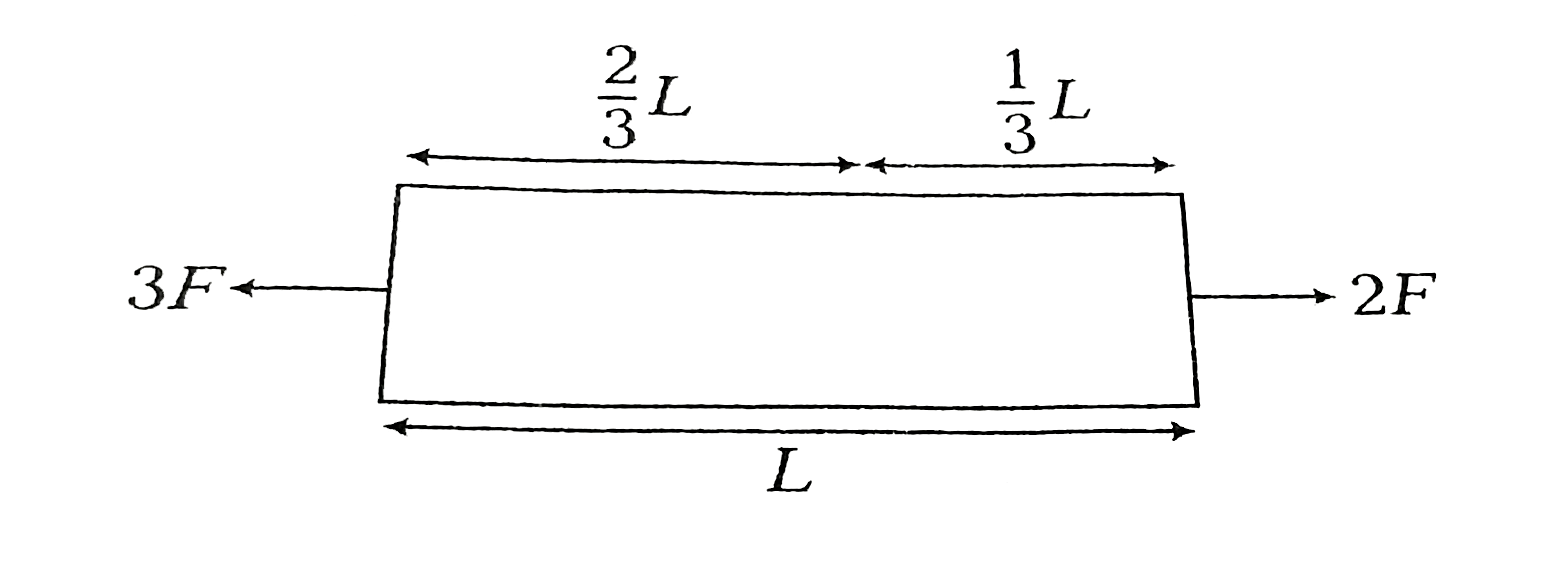A metallic rod of length l and cross-sectional area A is made of a material of Young's modulus Y. If the rod is elongated by an amount y, then the work done is proportional to
Y
1/Y
The correct Answer is:C
To solve the problem of determining how the work done on a metallic rod is proportional to the elongation, we can follow these steps:
Step 1: Understand the Definitions
- Young's Modulus (Y): It is defined as the ratio of stress to strain.
- Stress: It is defined as force (F) per unit area (A), i.e., Stress=FA.
- Strain: It is defined as the change in length (elongation, y) divided by the original length (l), i.e., Strain=yl.
Step 2: Relate Stress and Strain
Using the definition of Young's modulus:
Y=StressStrain=F/Ay/l
Rearranging gives us:
F=Y⋅A⋅yl
Step 3: Calculate the Work Done
The work done (W) on the rod when it is elongated by an amount y can be calculated using the formula:
W=Force×displacement=F⋅y
Substituting the expression for force from Step 2:
W=(Y⋅A⋅yl)⋅y=Y⋅A⋅y2l
Step 4: Determine the Proportionality
From the expression derived for work done:
W=Y⋅Al⋅y2
We can see that the work done (W) is proportional to the square of the elongation (y):
W∝y2
Conclusion
Thus, the work done is proportional to y2.
---
- Young's Modulus (Y): It is defined as the ratio of stress to strain.
- Stress: It is defined as force (F) per unit area (A), i.e., Stress=FA.
- Strain: It is defined as the change in length (elongation, y) divided by the original length (l), i.e., Strain=yl.
Using the definition of Young's modulus:
Y=StressStrain=F/Ay/l
Rearranging gives us:
F=Y⋅A⋅yl
The work done (W) on the rod when it is elongated by an amount y can be calculated using the formula:
W=Force×displacement=F⋅y
Substituting the expression for force from Step 2:
W=(Y⋅A⋅yl)⋅y=Y⋅A⋅y2l
From the expression derived for work done:
W=Y⋅Al⋅y2
We can see that the work done (W) is proportional to the square of the elongation (y):
W∝y2
Thus, the work done is proportional to y2.
Topper's Solved these Questions
- ELASTICITYBook:DC PANDEYChapter:ELASTICITYExercise:Chapter Exercise
Explore 73 Videos
- ELASTICITYBook:DC PANDEYChapter:ELASTICITYExercise:Match the columns
Explore 4 Videos
- ELASTICITYBook:DC PANDEYChapter:ELASTICITYExercise:Check point 12.2
Explore 15 Videos
- CURRENT ELECTRICITYBook:DC PANDEYChapter:CURRENT ELECTRICITYExercise:All Questions
Explore 434 Videos
- ELECTROSTATICSBook:DC PANDEYChapter:ELECTROSTATICSExercise:Integer
Explore 17 Videos
Similar Questions
A wire of length L and cross sectional area A is made of a material of Young's modulus Y. If the wire is streched by an amount x, the work done is………………
View SolutionA wire of length L and area of cross section A is made of a material of Young's modulus Y. If it is stretched by an amount x, the work done is given by
View Solution
Knowledge Check
A wire of length L and cross sectional area A is made of a material of Young's modulus Y. If the wire is stretched by an amount x, the work done is :
AYALxBYALx2CYA2LxDYA2Lx2A wire of length L and cross sectional area A is made of a material of Young's modulus Y. If the wire is stretched by an amount x, the work done is :
AYALxBYALx2CYA2LxDYA2Lx2A wire of length L and area of cross section A is made of a material of Young's modulus Y. If it is stretched by an amount x, the work done is given by
A2YAx2LBYAx2LC12YAx2LD12YAxL
A uniform rod of length cross- sectional area A and Young's modulus Y is subjected to two forces F and 2F at its two ends, stretching the rod.The heat generated in the rod is found to be (10a+b)F2l12AY .Find a+b.{a,b : Positive integers}
View SolutionA wire of length L and cross-sectional area A is made of material of Young's modulus Y. The work done in stretching the wire by an amount x is
View SolutionA metal wire of length L, area of cross-section A and Young's modulus Y behaves as a spring of spring constant k.
View SolutionA metallic rod of length 'L' and cross-section 'A' has Young's modulus 'Y' and coefficent of linear expansion 'α'. If the rod is heated to a temperature. 'T' the energy stored per unit volume is:
View SolutionA uniform cylindrical rod of length L and cross-sectional area by forces as shown in figure.

The elongation produced in the rod is
View Solution